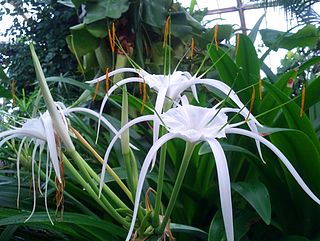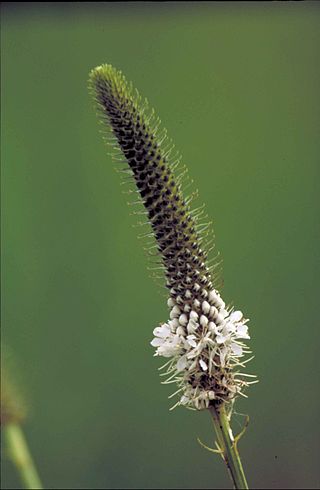
Hieracium , known by the common name hawkweed and classically as hierakion, is a genus of flowering plant in the family Asteraceae, and closely related to dandelion (Taraxacum), chicory (Cichorium), prickly lettuce (Lactuca) and sow thistle (Sonchus), which are part of the tribe Cichorieae. Hawkweeds, with their 10,000+ recorded species and subspecies, do their part to make Asteraceae the second largest family of flowering plants. Some botanists group all these species or subspecies into approximately 800 accepted species, while others prefer to accept several thousand species. Since most hawkweeds reproduce exclusively asexually by means of seeds that are genetically identical to their mother plant, clones or populations that consist of genetically identical plants are formed and some botanists prefer to accept these clones as good species whereas others try to group them into a few hundred more broadly defined species. What is here treated as the single genus Hieracium is now treated by most European experts as two different genera, Hieracium and Pilosella, with species such as Hieracium pilosella, Hieracium floribundum and Hieracium aurantiacum referred to the latter genus. Many members of the genus Pilosella reproduce both by stolons and by seeds, whereas true Hieracium species reproduce only by seeds. In Pilosella, many individual plants are capable of forming both normal sexual and asexual (apomictic) seeds, whereas individual plants of Hieracium only produce one kind of seeds. Another difference is that all species of Pilosella have leaves with smooth (entire) margins whereas most species of Hieracium have distinctly dentate to deeply cut or divided leaves.
A dry roadside dotted with small, ¾ inch red orange flowers, interspersed with very similar yellow ones, and often the white of daisies, is a good sign that you are in Hawkweed country.

The Cistaceae are a small family of plants known for their beautiful shrubs, which are profusely covered by flowers at the time of blossom. This family consists of about 170(-200) species in eight genera that are not very distinct, distributed primarily in the temperate areas of Europe and the Mediterranean basin, but also found in North America; a limited number of species are found in South America. Most Cistaceae are subshrubs and low shrubs, and some are herbaceous. They prefer dry and sunny habitats. Cistaceae grow well on poor soils, and many of them are cultivated in gardens.

Cardamine is a large genus of flowering plants in the mustard family, Brassicaceae, known as bittercresses and toothworts. It contains more than 200 species of annuals and perennials. Species in this genus can be found in diverse habitats worldwide, except the Antarctic. The name Cardamine is derived from the Greek kardaminē, water cress, from kardamon, pepper grass.

Ptilimnium is a group of plants in the family Apiaceae described as a genus in 1819. The common name is mock bishopweed or mock bishop's weed. It is endemic to the United States, primarily in the Southeast, the Lower Mississippi Valley, and the Lower Great Plains.

Lespedeza is a genus of some 45 species of flowering plants in the pea family (Fabaceae), commonly known as bush clovers or Japanese clovers (hagi). The genus is native to warm temperate to subtropical regions of eastern North America, eastern and southern Asia and Australasia.

Bartonia is a genus of the gentian family, tribe Gentianeae, subtribe Swertiinae. Members of this genus are called screwstems. Bartonia was also the name of a genus in the Loasaceae family, but those species are now generally classified under the genus Mentzelia.

Desmodium is a genus of plants in the legume family Fabaceae, sometimes called tick-trefoil, tick clover, hitch hikers or beggar lice. There are dozens of species and the delimitation of the genus has shifted much over time. Species are distributed widely – from Quebec to northern Argentina in the Americas, across northern and southern tropical Africa, in the southern Arabian Peninsula, in Myanmar and Thailand, New Guinea, and northern and eastern Australia.

Hymenocallis (US) or (UK) is a genus of flowering plants in the amaryllis family native to the Americas.

Dalea is a genus of flowering plants in the legume family, Fabaceae. Members of the genus are commonly known as prairie clover or indigo bush. Its name honors English apothecary Samuel Dale (1659–1739). They are native to the Western hemisphere, where they are distributed from Canada to Argentina. Nearly half of the known species are endemic to Mexico. Two species of Dalea have been considered for rangeland restoration.

Thymophylla is a genus of perennial flowering plants in the tribe Tageteae within the family Asteraceae. Pricklyleaf is a common name for plants in this genus.

Eleocharis is a virtually cosmopolitan genus of 250 or more species of flowering plants in the sedge family, Cyperaceae. The name is derived from the Greek words ἕλειος (heleios), meaning "marsh dweller," and χάρις (charis), meaning "grace." Members of the genus are known commonly as spikerushes or spikesedges. The genus has a geographically cosmopolitan distribution, with centers of diversity in the Amazon Rainforest and adjacent eastern slopes of the South American Andes, northern Australia, eastern North America, California, Southern Africa, and subtropical Asia. The vast majority of Eleocharis species grow in aquatic or mesic habitats from sea level to higher than 5,000 meters in elevation.

Tolumnia, is a genus in the family Orchidaceae. Previously known as the "equitant oncidiums," the species were segregated from the mega-genus Oncidium by Guido Braem in 1986. Dancing-lady orchid is a common name for some species in this genus.

Pycnanthemum is a genus of herbaceous plants in the mint family (Lamiaceae). Species in this genus are often referred to as "mountain mints" and they often have a minty or thyme-like aroma when crushed. All species of Pycnanthemum are native to the United States and Canada. The center of diversity for the genus is North Carolina with 13 of the 20 species having been collected therein. Nineteen of the 20 species of Pycnanthemum occur in the Eastern US and Canada, and one disjunct species occurs in California and Oregon.

Agalinis tenuifolia, known by the common names common gerardia, slender false foxglove or common false foxglove, is an annual forb native to the eastern and southwestern United States, and Canada, which produces purple flowers in late summer or early fall.

Pleea is a small genus of flowering plants described as a genus in 1803. There is only one known species, Pleea tenuifolia, the rush featherling, native to the southeastern United States.

Crocanthemum is a genus of flowering plants in the family Cistaceae. They are native to both North and South America where they are widespread. The common name frostweed relates to the ice crystals which form from sap exuding from cracks near the base of the stem in the late fall.

Lechea maritima, also known as beach pinweed, is a herbaceous perennial plant in the Cistaceae family found along coastal sandy dunes of the East Coast of the United States and into Atlantic Canada.

Lechea intermedia is a species of pinweeds in the Cistaceae. Common names for this species include large-pod pinweed, large-podded pinweed, intermediate pinweed, and round-fruited pinweed.























